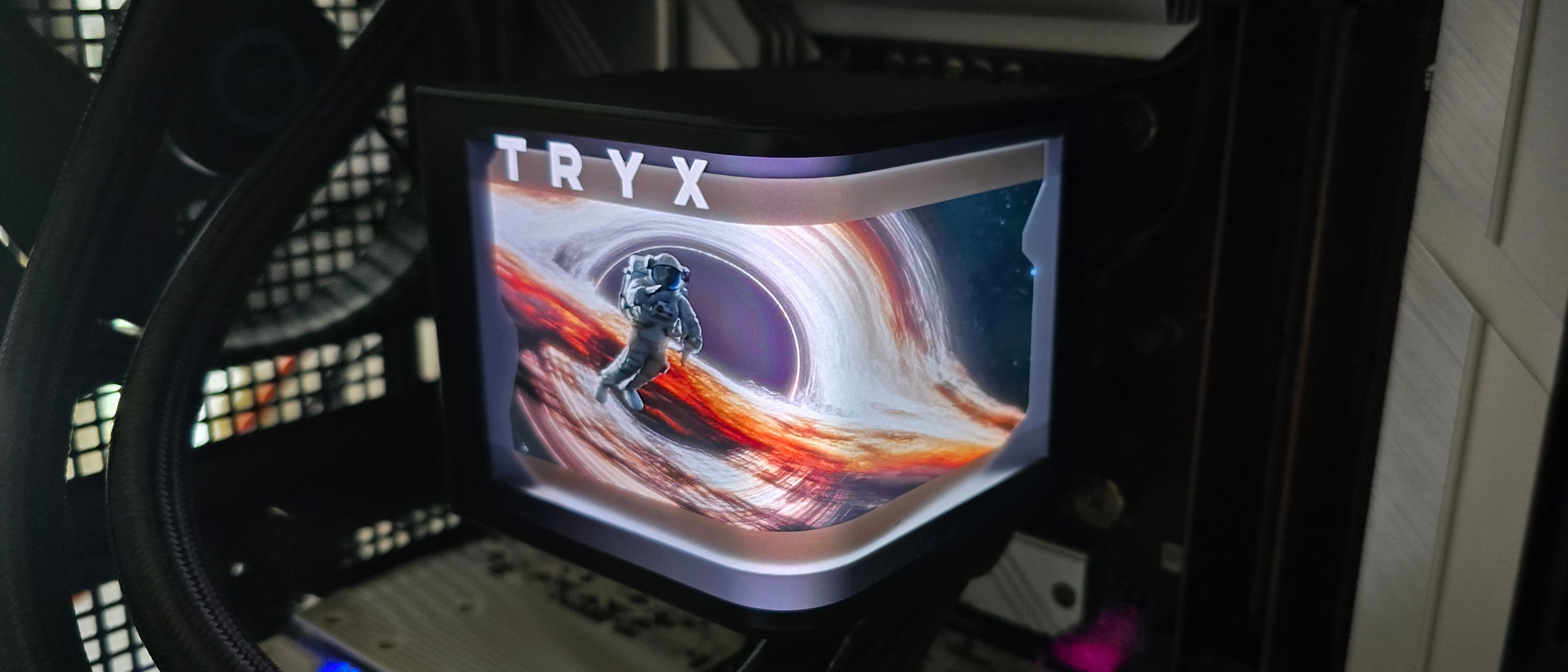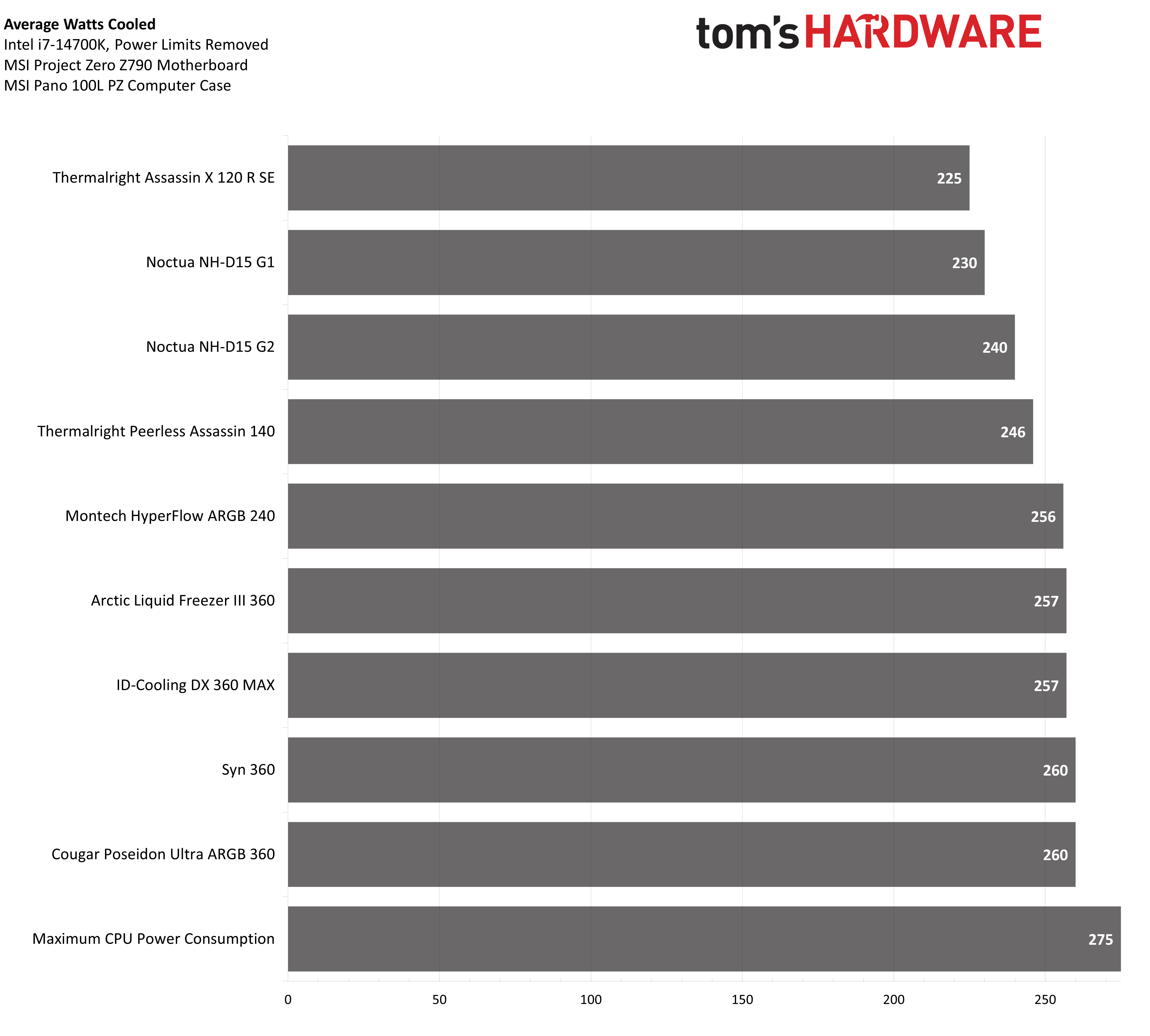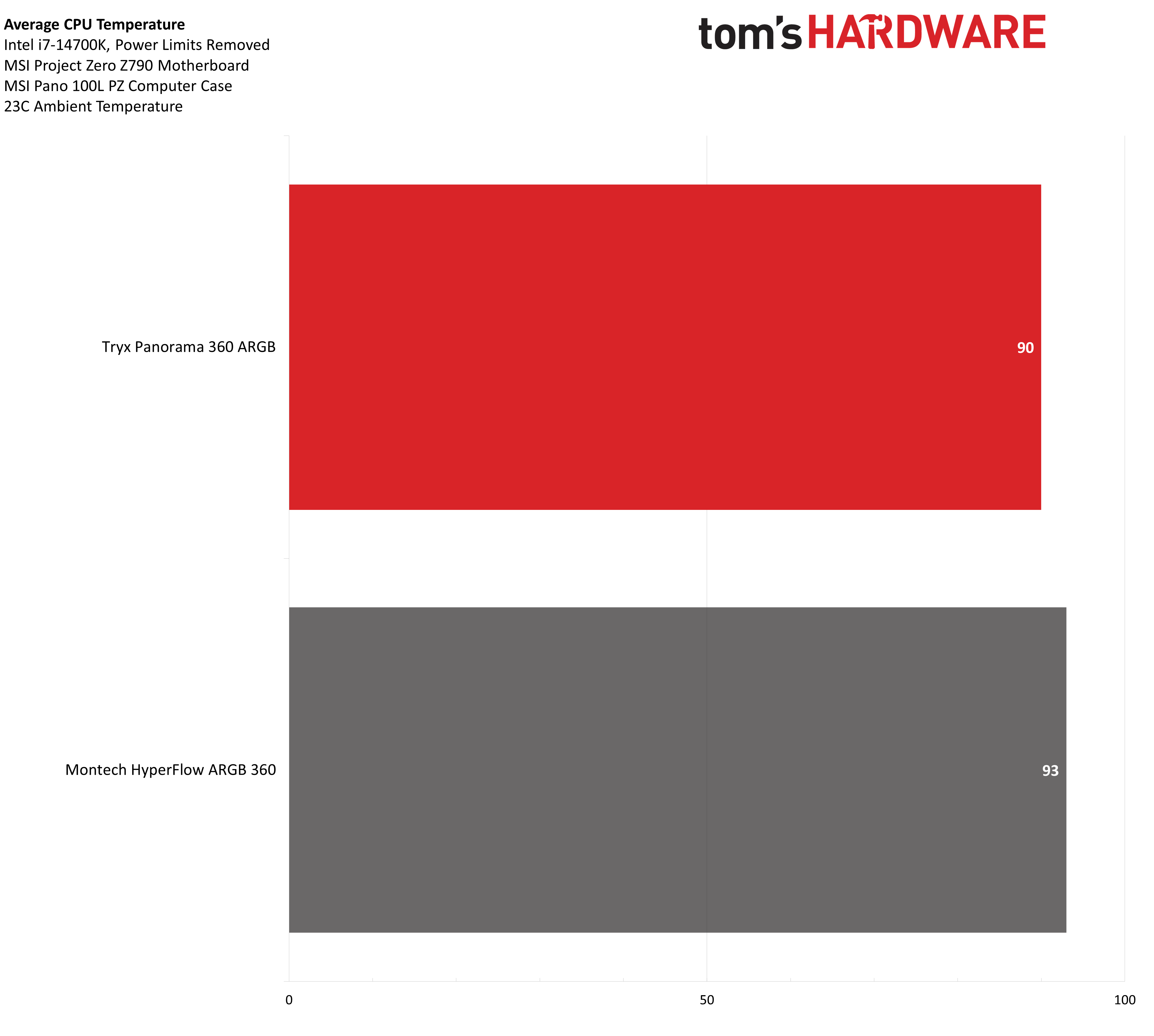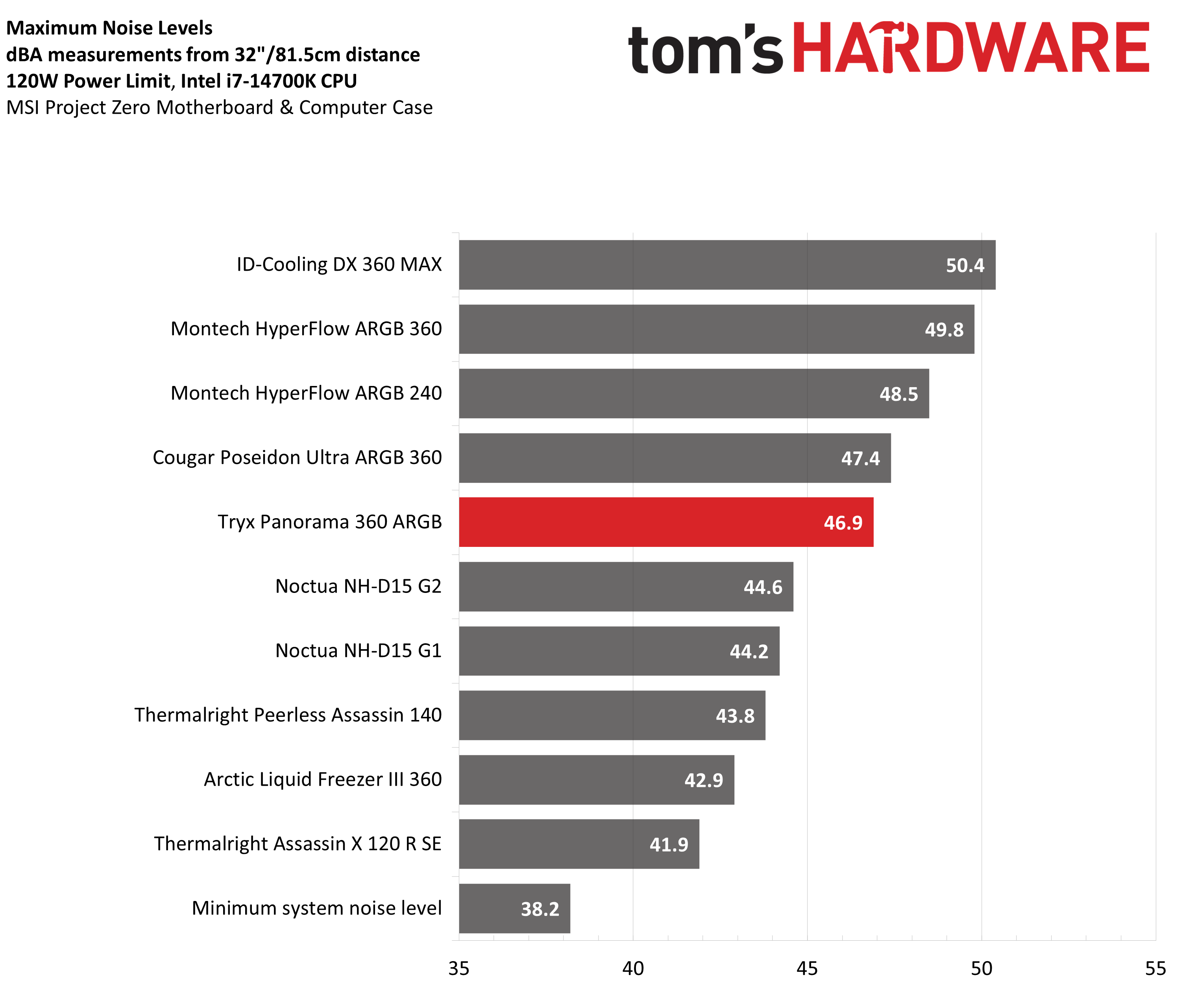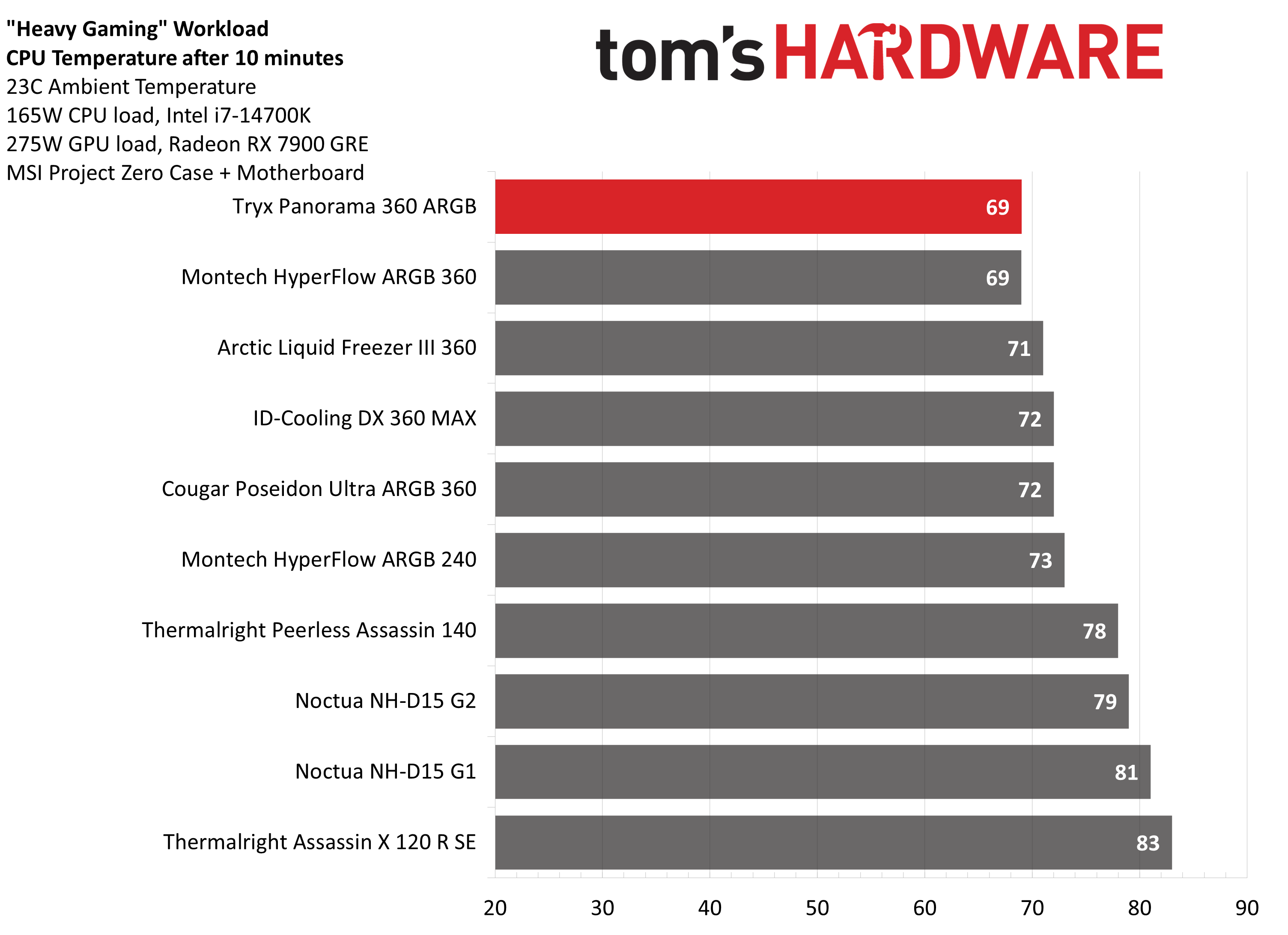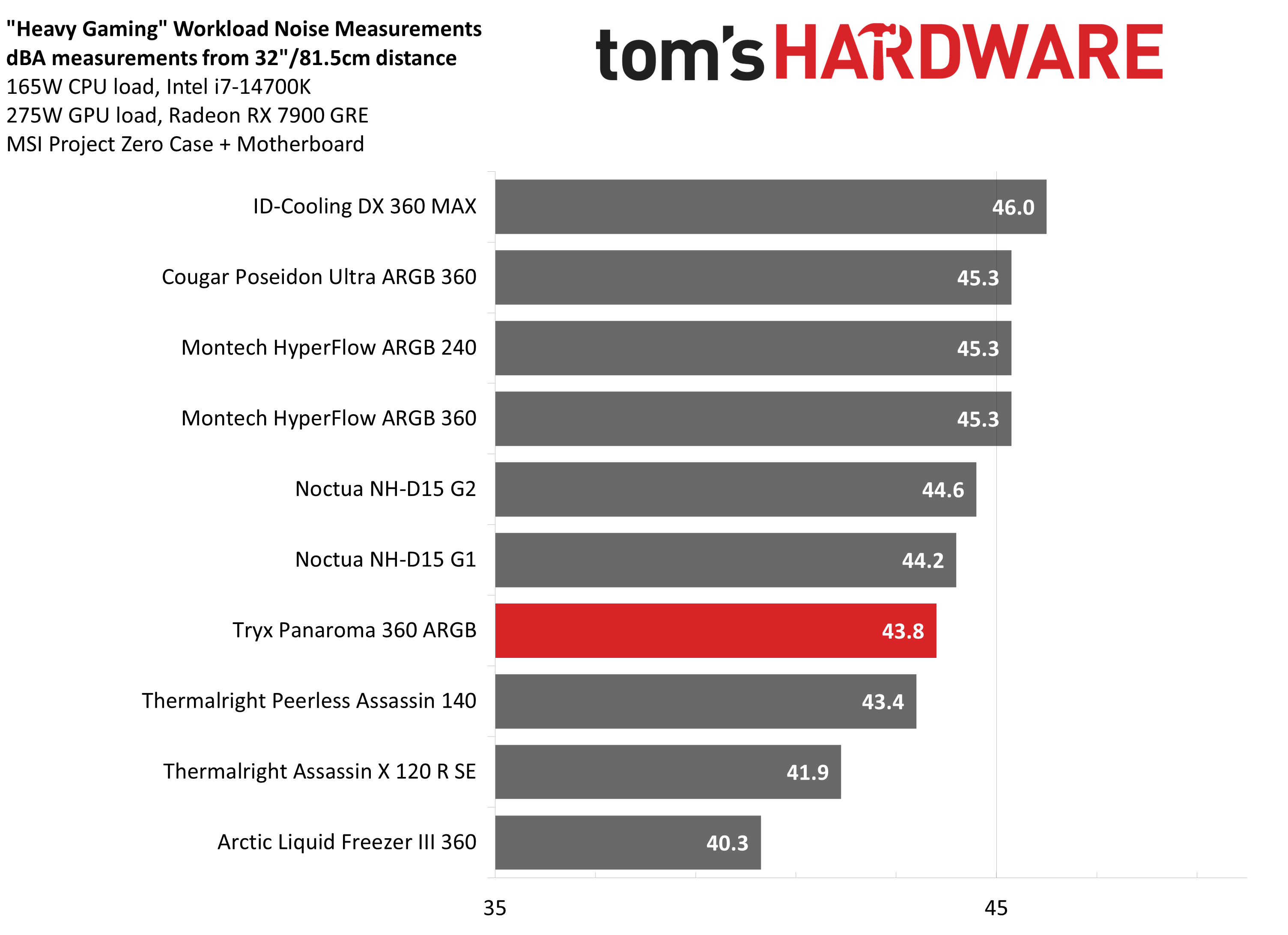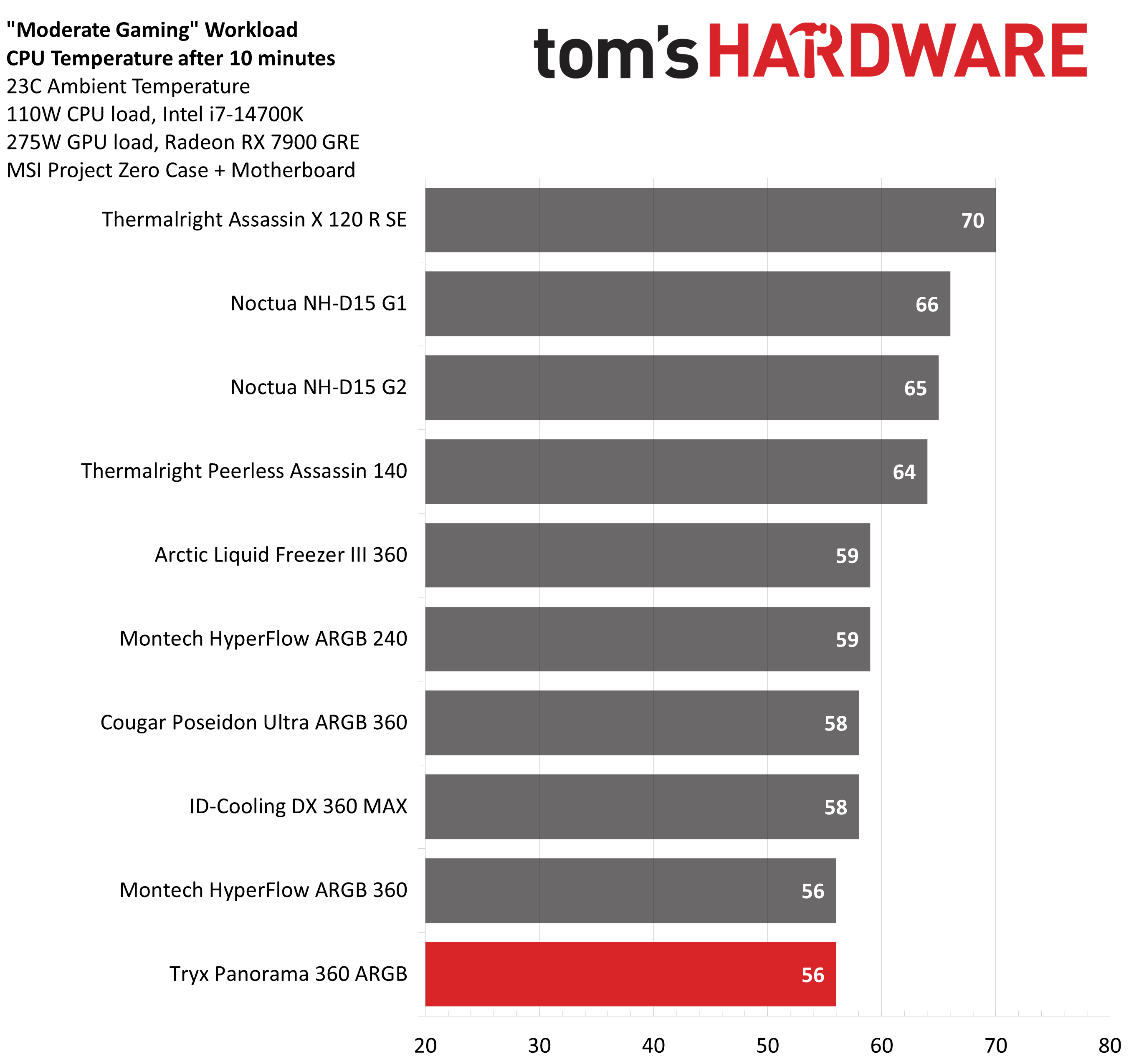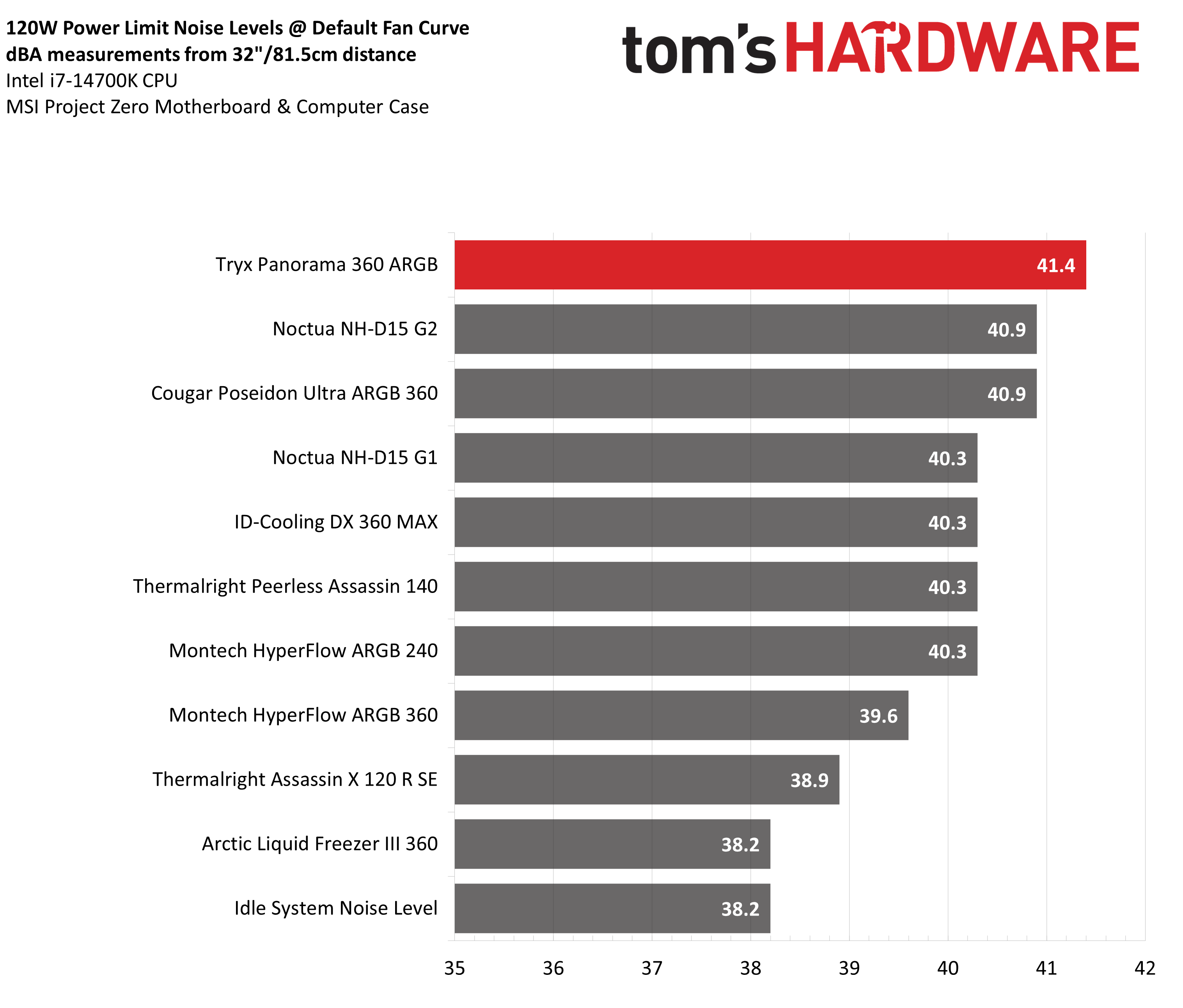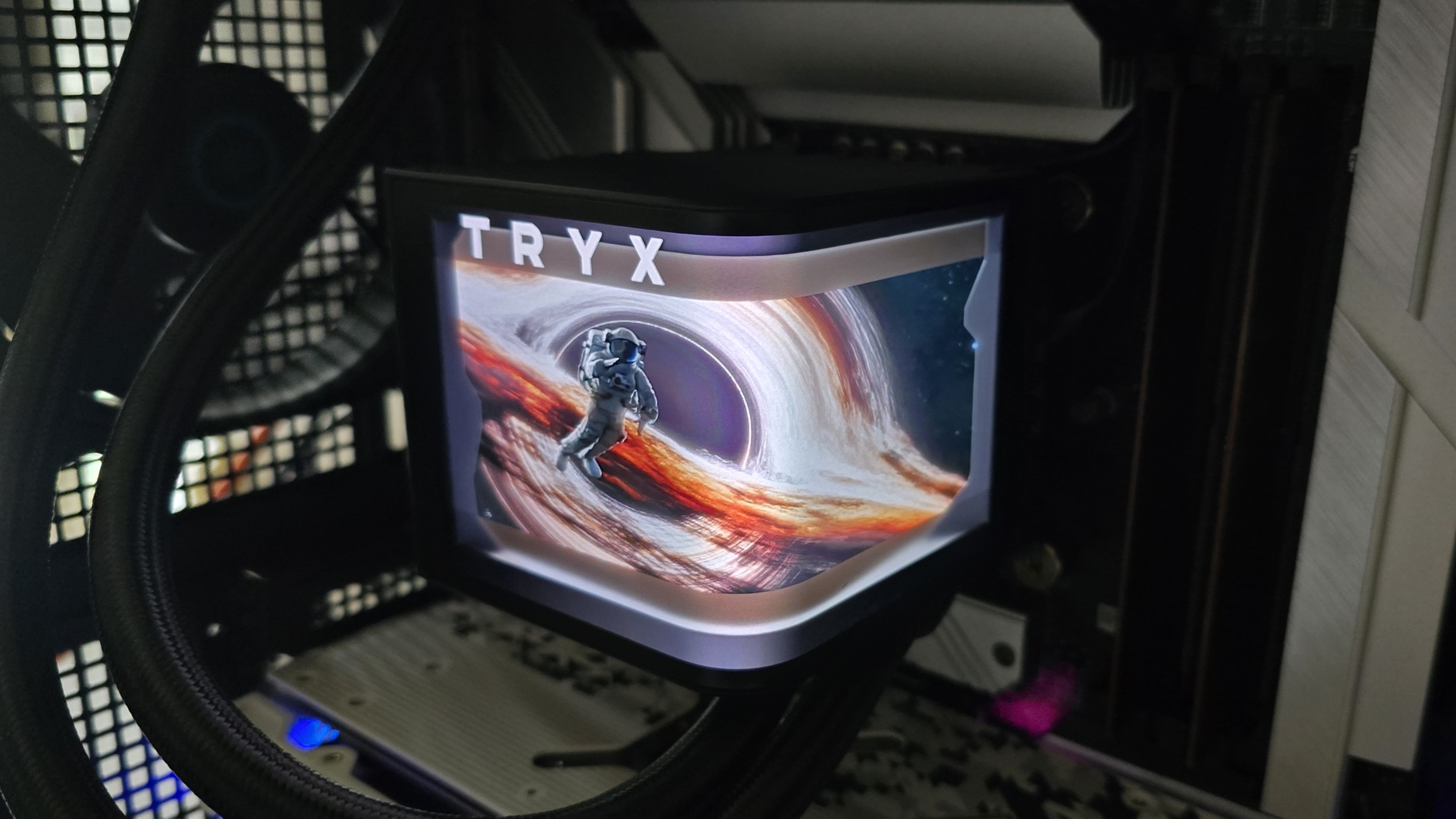Why you can trust Tom's Hardware
CPU Thermal results without power limits
Without power limits enforced on Intel’s i7-14700K, the CPU will hit its peak temperature (TJ Max) and thermally throttle with even the strongest air coolers. When the CPU reaches its peak temperature, I’ve measured the CPU package power to determine the maximum wattage cooled to best compare their performance.
The exception to this comes with the absolute strongest AIOs on the market, which can keep Intel’s i7-14700K under TJ Max. This is no small task. Testing Cinebench without power limits was hard on coolers when paired with the last generation i7-13700K, but the task is even more difficult using an i7-14700K, which has more e-cores and higher clock speeds. I fully expect most AIOs to “fail” this test and thermally throttle to a small extent.
As of this writing, only two liquid coolers that I have tested have been capable of keeping Intel’s i7-14700K under its maximum temperature of 100C (also known as TJ Max) during a 10-minute Cinebench test using MSI’s Z790 Project Zero motherboard with the power limits set to 4096. This test will cause peak CPU power consumption of up to 275W in this particular setup.
Of the seven AIOs I’ve tested thus far with Intel’s i7-14700K CPU, the Tryx Panorama 360 takes the crown for the best performance when power limits are removed.
The Panorama 360 AIO reached a noise level of 46.9 when its fans reached peak speeds. This isn’t exactly a quiet cooler, but it’s quieter than many others on the market – which can reach up to 55dBA.
Observant readers may notice that the graph starts at 35dBA, and might be worried that this starting point may cause graphs to be deceptive. But, noise level measurements are logarithmic. A person with typical hearing will perceive a doubling of noise for every 10 dBA increase, but the impact can vary from person to person.
Subjectively, I feel that a 5dBA increase feels like twice as loud – but I should add the disclaimer that I suffer from conditions that can make my ears more sensitive than others. 35dBA was chosen as the “zero” because it is the lowest level my noise meter can accurately measure.
Get Tom's Hardware's best news and in-depth reviews, straight to your inbox.
Thermal results with noise normalized to 38.9 dBA
Finding the right balance between fan noise levels and cooling performance is important. While running fans at full speed can improve cooling capacity to some extent, the benefits are limited and many users prefer a quieter system. With this noise-normalized test, I’ve set noise levels to 38.9 dba. This level of noise is a low volume level, but slightly audible to most people.
Unfortunately, when testing this unique AIO, I wasn’t able to normalize noise levels below 41 dBA. I reported this issue to the manufacturer weeks before writing this review in case there was a potential defect with the unit. This is a flaw that the most sound-sensitive of users might find unappealing, but I think that most users looking at potentially buying this product won’t mind the higher minimum noise levels – if you’re looking at this AIO, you’re probably looking for the best performance, hands down.
165W CPU + 275W GPU results
I’ve recently updated my testing methodology to better represent the scenarios a user might actually encounter in real-life use. The first of these new tests is designed to emulate, though not perfectly, a CPU-intensive game with a full GPU load. The Panorama 360 AIO matched Montech’s Hyperflow ARGB 360 for the best performance I’ve seen in this particular test.
While the fans can get noisy at maximum speed, they’re not so loud in this moderately intense gaming scenario. The Panorama 360 actually runs a little quieter than Noctua’s NH-D15 here, only reaching 43.8 dBA.
110W CPU + 275W GPU results
Our second round of CPU + GPU testing is performed with a lower CPU power limit, and in theory should be similar to games that are moderately intensive for a CPU. The Panorama 360 ties with its Montech competition for the best performance, averaging only 56 degrees Celsius.
120W Cinebench results
With my previous testing methodology, I used to record the temperatures and noise measurements using a 125W CPU-only test and I would emphasize how temperatures do not matter in this scenario.
As such, for this section, I’m only going to report noise levels – because that’s the only information that really matters for this test. The temperature of the CPU in this scenario is largely irrelevant, but the results for liquid coolers is similar to those reported above in the 110W + GPU tests if you are particularly concerned about this information.
This noise test highlights the Panorama’s one flaw – it has high minimum noise levels. No matter what settings were used, I registered a minimum noise level of 41.4 dBA – even while the computer was idle. While this isn’t a loud noise, users looking for silent coolers will not be satisfied by this noise output.
Conclusion
With a one-of-a-kind wrap-around 6.5-inch 2280x1080 AMOLED display and industry-leading thermal performance, the Tryx Panorama 360 is the Ferrari of AIOs – with a price to match at $349.99 USD. If you have a large budget and want the best-performing and most eye-catching design on the market, the Tryx Panorama 360 is the AIO that you’re looking for.

Albert Thomas is a contributor for Tom’s Hardware, primarily covering CPU cooling reviews.
-
das_stig When your cpu cooling solution costs as much as your cpu, things are just getting stupid !Reply -
thestryker Well at that price it seems to mostly serve as a justification to get a Hyte AIO to me. While the screen is certainly clever it's still just a generic Asetek AIO and the minimum noise level seems quite bad.Reply -
Heiro78 On page one under Testing Configuration, you've stated the i7-13700K, but the second page you show you've used the i7-14700K. I believe page one to be the typo.Reply
In the first chart, did you intend to show Maximum CPU Power Consumption as the last bar or was this supposed to represent the Tryx AIO's average watts cooled like the other coolers in the same chart? -
thestryker Reply
It's a bit confusing, but it's intentional as this cooler is able to cool the 275W this CPU uses at maximum. If they moved the next paragraph and graph above it I think it would be less confusing so you see the temperature performance and explanation first.Heiro78 said:In the first chart, did you intend to show Maximum CPU Power Consumption as the last bar or was this supposed to represent the Tryx AIO's average watts cooled like the other coolers in the same chart? -
Albert.Thomas Reply
Oh boy, that was a typo. Thanks for pointing that out.Heiro78 said:On page one under Testing Configuration, you've stated the i7-13700K, but the second page you show you've used the i7-14700K. I believe page one to be the typo.
In the first chart, did you intend to show Maximum CPU Power Consumption as the last bar or was this supposed to represent the Tryx AIO's average watts cooled like the other coolers in the same chart?
The first chart is where you'll find most coolers land - this chart shows the average power consumption in an unrestricted workload.
The Tryx AIO is not on this list because it was able to keep the CPU under it's maximum temperature, ergo the 2nd chart. I do not expect many coolers to "pass" this test.
Does that explain it better? -
This whole test is pointless for me, so we have a CPU cooler that keeps its fans at a higher level at all times than most others so its noisier which is the whole reason most folks go AIO or liquid to run quieter so fail number 1Reply
Then at maximum load yes its certainly cooler by a whopping 3Deg C than the Arctic cooler but way louder by the same 3 Decibels which as we know is non linear so 3 points on DB is a lot.
Then we come to price $350! The Arctic ARGB version is $240 less for 3DegC but less noise PFFh how can you as a honest reviewer even think to call this F1 level performance its a rip off its a generic pump cooler with a set of noisy fast fans and a fancy screen, not only that but you then compare it to an air cooler for noise!
Did you bother to run a 2 hour test to really soak the heat into the liquid?
My older custom loop which has a 3090Ti plus a 7900x with 1x480 and 2x360 with a 750ml reservoir can hit peak coolant levels of 38DegC after a very long OCCT test at max everything usually at least an hour, granted this is at least double the cost of the AIO but its a relevant test regardless and the systems effectiveness is in how long it takes to drop back to it nominal 5DegC over ambient -
BadBoyGreek Reply
Facts!das_stig said:When your cpu cooling solution costs as much as your cpu, things are just getting stupid ! -
scoob010 No Gallahad II performance 360 in the comparison?Reply
Just bought a LCD 280. Would have liked to know how the 360s stacked up after the 240 Tryx arrived. -
ultrasbm Reply
Yes!! How this even got passed all the "QC" is beyond me...it's not even a nice sound, it's just horrible :-\craigss said:This whole test is pointless for me, so we have a CPU cooler that keeps its fans at a higher level at all times than most others so its noisier which is the whole reason most folks go AIO or liquid to run quieter so fail number 1
